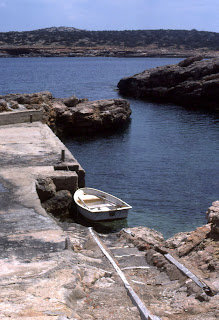 |
| Tropic Moon at anchor, Isla Conejera. The island of Ibiza is visible in the background. |
To go to the beginning of this book, Tropic Moon: Memories, click HERE.
A less
pleasant aspect of cruising was keeping up with the boat maintenance. Our
topsides paint had suffered grievously over the winter from oil spills in the
Gibraltar harbor, chafing fenders when we were sandwiched in between other
boats, and the occasional rude encounter with a marina dock. We decided
to repaint the white hull while at anchor in our peaceful cove. Ed spent
one day cleaning and sanding the hull, and epoxying over a few of the scars.
Unfortunately, on the following day when we were ready to paint, our cove was
less than peaceful. The wind had
shifted, and Tropic Moon was rolling in response to a gentle swell. After
setting a stern anchor, Ed and I climbed into the dinghy. With me hanging on to the cap rail as the
dinghy rose and fell, Ed proceeded to paint his way around the hull. He
had some competition from the swells as to who would wet the waterline
first. Occasionally, when Ed was the winner,
a wave would then come along and playfully wash off some of the new paint.
 |
| The lighthouse, visible on the top of the promontory. |
We were anchored near the middle of Isla Conejera, while the lighthouse was located at the northern end. Before our hike up to the lighthouse, (which we found deserted), we had enjoyed some interesting speculation about the keeper of the light. It was Ed's opinion that the keeper was locked away up there in the tower. Ed mentioned his possible presence when we took to sunbathing nude on the deck. I couldn't believe that anyone would be living in the lighthouse when there wasn't even another boat at the island. I chose to elect a man as keeper when he showed up in a small boat, and then disappeared for a time. Ed took him to be a fisherman.
I then
elected a second man, who came in a powerboat with his family, which he moored
at the landing dock. He also disappeared (he was probably napping on the
boat), while an older woman, robed in a somber black dress, stood atop a rocky
abutment, and wielded a fishing rod with considerable success. (I watched
her catch fish while she watched us paint the boat.) Two younger women in
bikinis were sunning themselves, and keeping an eye on a couple of youngsters,
while a frisky black dog gamboled about the cliffs, no doubt bringing terror to
the resident lizard population, and consternation to the sea gulls attempting
to sun themselves in peace.
Conejera may translate to
"rabbit-warren," but it was lizards we saw everywhere, and nary a
rabbit in sight. The lizards scurried from rock to rock, most of
them colored in a drab gray-green to blend in with the landscape, while others were arrayed in intense blue-greens, appearing iridescent in the bright
sunlight. There seemed to be almost as many seagulls as lizards. I remember one particular gull that, unlike
his friends, didn't fly off at my approach, and who seemed unconcerned by the
loud-sounding snaps on my camera case that broke the quiet when I opened
it. The gull appeared to straighten his neck, and then stared straight
ahead at the camera. I wanted a shot of the gull turned sideways, and
madly waved one arm in the air. I didn't expect the gull to understand
what I wanted, but I thought my actions might cause him to prepare for
flight. He was having none of it, and insisted on posing stiff-necked,
face forward, until I had taken his picture. |
| My seagull... |









































